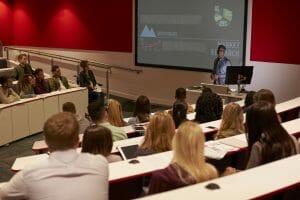
A college education was once a marker of accomplishment and brought with it an increased annual salary, a foundational network of professionals in a given field, and the training necessary to excel in the workplace. But today, the sharp increase in tuition over the past twenty years along with doubts over the efficacy of said education are causing many to scratch their heads, wondering if college is even worth it. At the center of this question lies the predominant university pedagogy, or the method by which professors educate their students. In most institutions, departments in classes, the pedagogy hasn’t changed much in roughly 1,000 years. It is known as the ‘lecture.’

The High Middle Ages, or the period roughly between the 11th and 14th centuries, was one of growth and development for the continent of Europe. More and more people left rural areas to settle in the city. Education became more widely available. Before long so many students flocked into monastic schools that monasteries had to devote some of their personnel entirely toward teaching one subject. One instructor, furthermore, couldn’t hope to reach every student in a class of 50 on an intimate level. Accordingly, they adopted a new approach: professors stood in front of an assembly of students and read from their notes. Before the advent of the printing press, lecturers might have referred to an institution’s single copy of a text from which to teach. While the method wasn’t as precise as manuscript reproduction, it was a pretty good alternative.
For hundreds of years, this was the best, most efficient way to educate learners. When the Gutenberg’s printing press became more widespread, students could at least potentially access books from which material was drawn, but they still benefited from a person in front of them who could explain it.
Many important contributions to Western thought existed only in lecture form, and what we know of them comes exclusively from students taking down notes. The linguist and philosopher Ferdinand de Saussure, for example, never published his theories. Socrates didn’t believe in writing things down at all. And yet we have their musings because students took notes from their lectures.
Fast Forward
 In the last fifty years, people have invented technology which lecturers from the High Middle Ages could not begin to dream up. In 2017, 300 minutes of video (much of it instructional) was uploaded to YouTube every minute. Anyone with a smartphone has better access to information than world leaders from a previous generation and more computational power than NASA just decades ago.
In the last fifty years, people have invented technology which lecturers from the High Middle Ages could not begin to dream up. In 2017, 300 minutes of video (much of it instructional) was uploaded to YouTube every minute. Anyone with a smartphone has better access to information than world leaders from a previous generation and more computational power than NASA just decades ago.
And yet most universities continue to rely on the lecture as the primary method for conveying information. Universities are centers of research and innovation. Ten of the top-funded U.S. universities have annual R&D budgets of over $1 billion. But still, most professors use seriously outdated technology to convey information. This statement applies in several areas, and we have listed a few below:
Lectures Are Ineffective
Scott Freeman, a professor of biology at the University of Washington, conducted a study in 2014 pitting lecture-based classes against methods that asked students to become ‘active participants’ in the class. With a sample of 225 students in undergraduate STEM courses, Freeman and his team found that turning students into active participants reduced failure rates by one standard deviation.
“If you have a course with 100 students signed up, about 34 fail if they get lectured to but only 22 fail if they do active learning, according to our analysis,” Freeman said, according to the National Science Foundation. “There are hundreds of thousands of students taking STEM courses in U.S. colleges every year, so we’re talking about tens of thousands of students who could stay in STEM majors instead of flunking out every year.”
Lecturers Are Slow to Adopt New Technology
According to an anonymous U.K. lecturer writing for Vice, most lecturers are living in the past. For their classes, they rely on communication methods that they used when last working outside of universities. “This general institutional conservatism at colleges means that a lot of the time, I feel like I’m teaching a course that would have made sense 15 or 20 years ago,” she/he writes. “Universities, especially those peddling new degrees, need to get over their anxiety and create courses that better reflect the working world as it exists.”
In the Age of AI, EdTech, and Online Learning, Lectures Miss the Point
A recent report written by Getting Smart on the current state and future of AI had a lot to say about education and beyond. But one of the main takeaways for the classroom is that teachers will have to begin to do everything that an AI bot cannot. A bot might be able to curate and condense relevant educational material, and even serve as an effective TA. But when it comes to the social and emotional realms—areas that are just as important in education as academic areas—teachers alone are suited to aid and instruct their students.
But the lecture does just the opposite. It makes a professor’s connection with his or her students less personal and, besides the potential odd question to the class, precludes the possibility of active participation.
Lectures Misuse Space
The spatial orientation of a lecture hall is necessarily one-way. It mimics that of a theater: many gather in one room to watch a thing. Lecture halls need to be massive enough to hold as many as 500 students or more. And yet they can only be used for one thing: the same inefficient method of teaching that is quickly approaching its 1000th birthday.
The space of a lecture hall need not follow this prescribed outline. Take, for example, the spaces in which first year physics students at MIT learn. It is filled with round tables. Several video monitors line the walls. The instructor’s workplace is situated directly in the center of the room. The university calls this Technology-Enhanced Active Learning (TEAL). Along with the lecture hall redesign, first year students learn in a more flipped scenario, and professors heavily employ group work in favor of lecturing. “The teaching methods used in the TEAL classroom produced about twice the average normalized learning gains for low-, intermediate-, and high-scoring students when compared to traditional instruction,” the program found.
The lecture is a product of the age in which it was invented. The fact that it has survived over the centuries is a testament to its one-time efficacy. That age, however, is over. It is time to forgo the pedagogy in exchange for more suitable teaching methods, such as group work, informal quizzing, flipped learning, online help seeking and other strategies that have proven effective.









No Comments